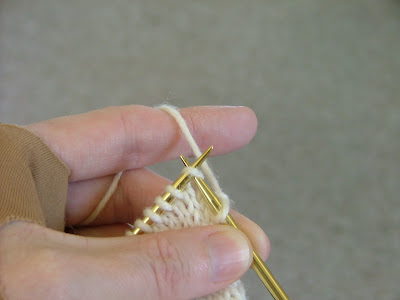
The first of July is the official one-year anniversary of this blog! For me the year has passed really quickly. There have been times when I have had to scratch my head a bit to think of what to post about next, and many more times when I've had too much to say to fit it all into one post. I've posted about things that I have encountered in the projects I'm working on, about questions on techniques that I am hearing from my private lesson students, and things that are new to the shop. In the end, what I hope to provide you with in this blog is not only information about what is happening at Kiwi Knitting Co., but also hints to help you become better and more confident knitters. There are some rules in knitting that are 'What ever works for you and gets the job done', and some rules that are carved in stone in order to make a certain thing happen in a certain way. I hope I have helped you to understand the process better, and to grow as a knitter.
In turn, Lynn and I want to thank you for making the first year of the blog so successful! Last I looked, we had over 8000 hits on the blog in the last year. One of the blog posts (on The Afterthought Pocket) was used as a reference by the Mistress of knitting blogs, the Yarn Harlot herself. I thank you all for being such faithful and devoted readers, and for all the great feedback you give Lynn and myself on what you see here.
So, how do we thank you, and make it fun at the same time? We're having a contest! A little quiz, if you like. Here is all you need to do- Download and print out the quiz sheet by following the link at the bottom of this blog post. Answer the quiz questions - remember, this is an open-blog test! Some of the questions are a piece of cake, some you can find the answers to in previous blog posts. Fill out the answer sheet, and bring it into Kiwi anytime between July 7th & 31st. Be sure to add your name and phone number on your answer sheet. All entries must be handed in to Kiwi Knitting by close of business on Thursday, July 31st.
On Saturday, August 2nd, Lynn will draw a prize winner from among the entries that had all the questions answered correctly. You don't need to be present in order to win the prize, but you are welcome to stop into the shop and see who wins!
And what do you win? Do you see that gorgeous Della Q knitting bag up at the top of the page? That could be yours. Along with the $30.00 gift certificate to spend on a project to fill the bag with, and a one-hour private lesson with me, Lynda Sorenson, on anything knitting or crochet related that you care to bring to the table. Altogether, this package is worth $98.00! That's how much we appreciate you!(Actually, we appreciate you a whole lot more than that, even!)
Now the neat thing, is that everyone who enters gets a little something, whether you win the big prize or not. On the day that you bring in your completed entry form, you can get a 10% discount on any yarn purchase made that day. Now that is certainly worth going out during the daytime in Tucson's summer!
Keep in mind that Kiwi Knitting Co. will be closed for July 4th week, from Monday, June 30th through Sunday, July 6th, and will re-open on Monday, July 7th.
Here's a link to the quiz page. Thanks so much! And good luck!
























